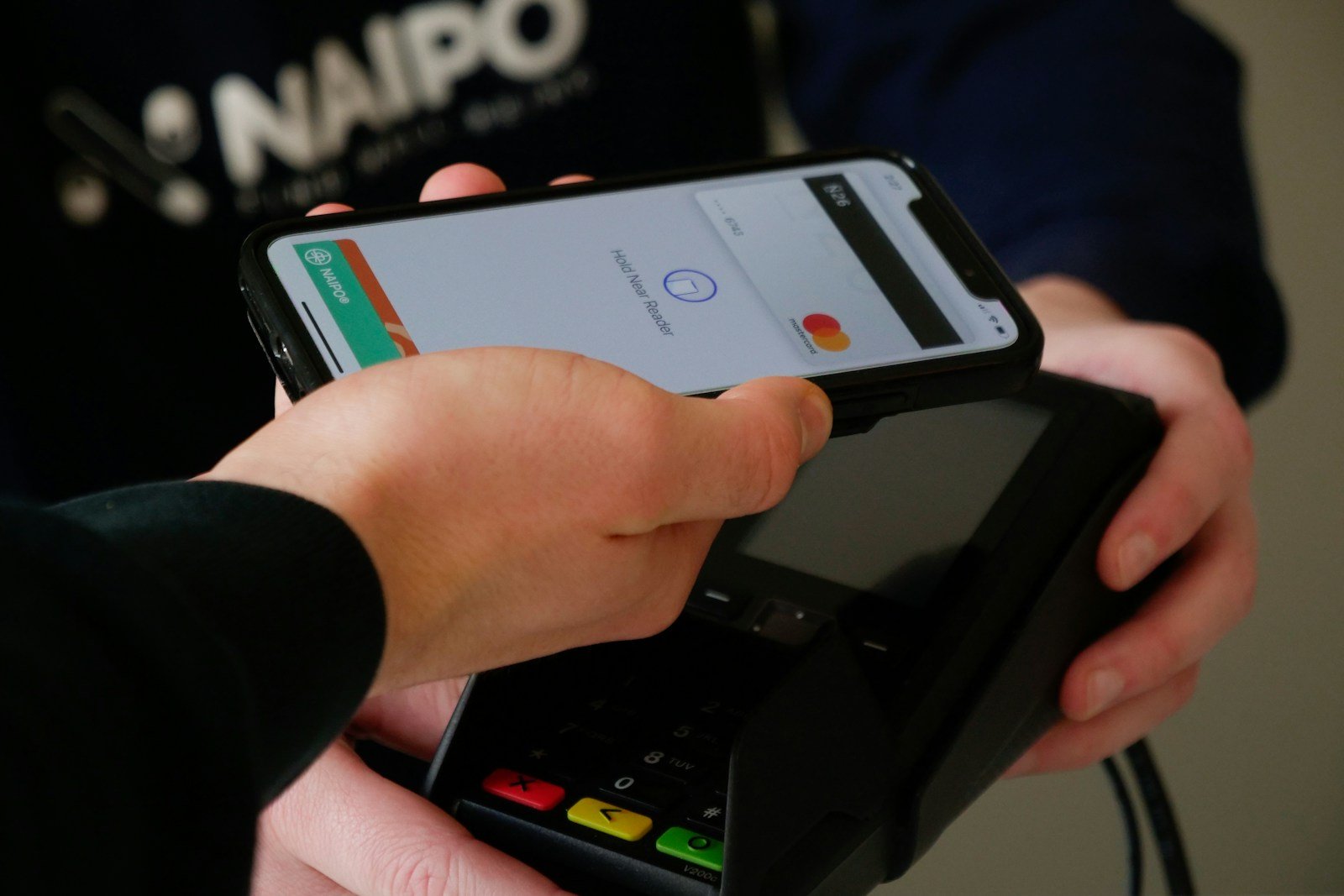Is your Apple Pay not working? This handy payment tool can sometimes stop working when you’re trying to pay at the store or send money to friends. You can fix most Apple Pay problems with a few simple steps like checking your connection, restarting your device, or making sure your cards are properly set up. Many people face these issues, and the solutions are usually quick and easy.
Apple Pay problems can happen for many reasons. Your device might need an update. Your bank could have blocked the card. The store’s payment terminal might not work with Apple Pay. Sometimes the fix is as simple as signing out of your Apple ID and signing back in again.
1. ✅ Check Apple Pay Availability
- Make sure Apple Pay is supported in your country/region.
- Confirm that your bank or card issuer supports Apple Pay.
2. 📶 Check Internet & Connection
- Apple Pay needs Wi-Fi, cellular, or NFC to work.
- If using in-store: ensure NFC is enabled (on iPhone, just hold near terminal).
- Try toggling Airplane Mode on/off.
3. 💳 Verify Your Cards
- Open the Wallet app → check if your card is still active.
- If a card shows “Verification Required,” follow the prompts.
- Remove and re-add the card if it’s not working.
4. 🔄 Restart Devices
- Restart your iPhone, iPad, Apple Watch, or Mac.
- Restart the payment terminal (if possible, ask the cashier).
5. ⚙️ Update Software
- Go to Settings → General → Software Update.
- Install the latest iOS, iPadOS, watchOS, or macOS update.
6. 👤 Check Apple ID & Region Settings
- Go to Settings → [Your Name] → iCloud & Apple ID.
- Sign out and back in if needed.
- Ensure your region matches your card’s issuing country:
- Settings → General → Language & Region.
7. 🔐 Check Security Settings
- Make sure Face ID, Touch ID, or passcode is enabled.
- Apple Pay won’t work if your device doesn’t have secure authentication set up.
8. 🛒 In-Store Payment Tips
- Confirm the terminal supports Apple Pay.
- Hold your iPhone/Watch closer to the reader.
- Try selecting your card manually in Wallet before tapping.
9. 🧹 Reset Settings (Last Resort)
- Go to Settings → General → Transfer or Reset iPhone → Reset → Reset All Settings.
- This won’t erase data, but it resets Wi-Fi, Bluetooth, and Apple Pay settings.
10. 📞 Contact Support
- If nothing works, contact:
- Apple Support: support.apple.com
- Your bank or card issuer
✅ Following these steps usually fixes most Apple Pay issues, whether it’s failing in stores, online, or when adding a card
Key Takeaways
- Check that your device and location support Apple Pay and that you have a good internet connection before troubleshooting further
- Restart your device, verify your identity, or try selecting a card manually to fix common Apple Pay glitches
- Contact your bank or card issuer if Apple Pay problems persist as they may need to approve your card for digital wallet use
Understanding Apple Pay and Its Requirements
Apple Pay lets you make secure, contactless payments with your iPhone. Before you can use it, you need to set up your device correctly and make sure your payment methods are compatible.
Apple ID Region and Payment Method
Your Apple ID region affects which cards you can add to Apple Pay. Not all banks support Apple Pay in all countries. If your card isn’t working, check if your card issuer supports Apple Pay in your region.
Some users find that their cards are declined because the billing address doesn’t exactly match what’s on file with the bank. Make sure your billing information is correct in your Apple ID settings.
If you’ve recently moved countries, you might need to update your Apple ID region. This can be done in Settings > Your Name > iTunes & App Store.
Multiple cards can be added to Apple Wallet. You can set a default card for quick payments or choose different cards during checkout.
Supported iPhone Models and iOS Version
Apple Pay works on iPhone 6 and newer models. Older iPhones lack the needed NFC chip for contactless payments.
Your iOS version must be up to date for Apple Pay to work properly. Check for updates in Settings > General > Software Update.
iPhone SE, iPhone 6, 6 Plus, and newer support in-store payments. For older models, you can only use Apple Pay for online or in-app purchases with an Apple Watch.
If Apple Pay suddenly stops working, check if you need an iOS update. New security features are added regularly, and outdated software can cause problems.
Make sure NFC is turned on. Some users report that Apple Pay fails because NFC is disabled.
Setting Up Apple Wallet
To add a card to Apple Wallet, open the Wallet app and tap the plus sign. You can scan your card or enter details manually.
Follow the verification steps from your bank. This might include a text message, email, or phone call to confirm it’s really you.
Some cards need extra verification steps. If setup fails, contact your card issuer to check if there are any issues with your account.
Check that your card isn’t expired or blocked. Banks sometimes block Apple Pay transactions if they detect unusual activity.
If all else fails, try removing the card and adding it again. This often fixes issues with cards that won’t load properly or keep getting declined.
Common Issues and Solutions
When Apple Pay stops working, several key problems typically arise from system issues, device restrictions, or payment information problems. Fixing these issues usually requires specific troubleshooting steps.
Checking for iOS System Issues
Make sure your iOS is up to date. Outdated software can cause Apple Pay to fail. Check this by going to Settings > General > Software Update.
Your device’s date and time settings must be correct for Apple Pay to work properly. Go to Settings > General > Date & Time and turn on “Set Automatically.”
If Apple Pay still isn’t working, check if there are any service outages affecting the system. Apple sometimes has temporary problems that can affect payment processing.
Try restarting your device. This simple step often fixes many Apple Pay problems by clearing temporary system glitches.
Evaluating Restrictions and Screen Time
Screen Time limits might block Apple Pay functions. To check this:
- Open Settings
- Tap Screen Time
- Select Content & Privacy Restrictions
- Look for “Apple Pay” under “Allowed Apps”
Make sure Apple Pay is not accidentally restricted. Some restrictions can prevent adding cards or making payments even when everything else seems normal.
Family Sharing restrictions might also affect Apple Pay for child accounts. If you’re managing a family account, check that the proper permissions are set up for each user.
For work phones, company restrictions might block Apple Pay. Ask your IT department if Apple Pay is allowed on your device.
Verifying Payment Information and Billing Details
Outdated or incorrect card information is a common problem. Check that your card hasn’t expired and the security code is correct. Remove and re-add cards to your Apple Wallet to refresh all information.
Some cards get declined due to bank restrictions or insufficient funds. Contact your bank to make sure:
- Your card is activated for digital wallet use
- There are no spending limits or blocks on your account
- The bank isn’t flagging Apple Pay charges as suspicious
Verify your billing address matches what’s on file with your bank. Even slight differences can cause payment rejections.
Always check that your payment cards are properly set up in Wallet. Some cards require additional verification steps through your bank’s app or website before they work with Apple Pay.
Advanced Solutions to Fix Apple Pay
When basic fixes don’t solve your Apple Pay issues, it’s time to try more technical approaches. These methods can help resolve deeper system issues that prevent Apple Pay from working properly.
Using iOS Repair Tools
If your Apple Pay problems persist, specialized repair software might be the answer. Tenorshare ReiBoot is a powerful tool that can fix many iOS system issues without data loss. This software repairs the underlying system that might be causing Apple Pay failures.
Another helpful option is Fonelab iOS System Recovery, which targets specific iOS glitches. These tools work by:
- Fixing system crashes that affect Apple Pay
- Resolving verification problems
- Repairing corrupted iOS elements
To use these tools, users need to:
- Download the repair software to a computer
- Connect the iPhone with a cable
- Select the repair option (standard repair is safest)
- Follow on-screen instructions to complete the process
Contacting Apple Support for Assistance
When technical solutions fail, Apple Support offers expert help for Apple Pay issues. Users can reach out through multiple channels for personalized assistance.
The Apple Support app provides direct connection to specialists who understand Apple Pay problems. Users can also visit an Apple Store for in-person help with complex issues.
When contacting support, it’s helpful to:
- Have your Apple ID ready
- Know which cards are having issues
- Explain all troubleshooting steps already tried
- Be ready to share error messages
Apple’s support team can check if your account has restrictions or if there are known issues affecting your region. They might also verify if your bank is experiencing Apple Pay integration problems.
Network Settings and System Repair
Network issues often prevent Apple Pay from working properly. Resetting network settings can fix connection problems that block Apple Pay verification.
To reset network settings:
- Go to Settings > General > Transfer or Reset iPhone
- Tap Reset > Reset Network Settings
- Enter your passcode and confirm
This clears saved WiFi networks and Bluetooth connections, potentially fixing connection issues. For more stubborn problems, try these additional steps:
- Reset Safari settings if Apple Pay fails on websites
- Update carrier settings through Settings > General > About
- Toggle Airplane Mode on and off to refresh connections
If all else fails, a full system repair might be necessary. This involves backing up your data and either resetting all settings or restoring your device through iTunes or Finder.
Troubleshooting Payment Issues
When Apple Pay stops working during payment, several specific issues might be blocking your transactions. Understanding the root causes can help you quickly fix the problem and get back to making payments.
Dealing with In-App Purchases and Subscriptions
If your Apple Pay fails during in-app purchases, first check your Apple ID payment information. Make sure it’s up to date in Settings > Your Name > Payment & Shipping.
Try these quick fixes:
- Sign out of your Apple ID and sign back in
- Update your iOS to the latest version
- Restart the app where the purchase is failing
For subscription issues, go to Settings > Your Name > Subscriptions to check if any payment methods need updating. Sometimes clearing the App Store cache can help resolve stubborn issues.
If a specific app consistently fails, try deleting and reinstalling it. This refreshes app data and often fixes payment connections that might have broken during updates.
Ensuring Correct Wallet App Functionality
The Wallet app needs proper setup to work correctly. First, check if your device is compatible with Apple Pay and running the latest software.
To reset Wallet functionality:
- Go to Settings > Wallet & Apple Pay
- Check that Apple Pay is enabled
- Verify your cards are properly added and not expired
If cards show but won’t work, try removing and re-adding them. Tap the problematic card and select “Remove Card.” Then add it again by tapping the “+” icon in Wallet.
Network connection problems often cause payment failures. Switch between WiFi and cellular data to see if connectivity is the issue. Sometimes just restarting your device completely resolves the problem.
Contact Your Bank for Payment Card Problems
When Apple Pay declines transactions despite everything else working correctly, the issue likely involves your bank. Card rejections happen for several reasons:
- Insufficient funds
- Unusual purchase patterns triggering fraud alerts
- Card expiration or information mismatch
- Bank-side system maintenance
Call the number on the back of your physical card for immediate help. Bank representatives can check for restrictions or fraud alerts that might be blocking your Apple Pay transactions.
Some banks limit digital wallet spending or require additional verification for Apple Pay. Ask specifically if any special authorization is needed for your card to work with Apple Pay. The bank can often fix these issues while you’re on the phone.
Final Steps If Apple Pay Is Still Not Working
If you’ve tried basic troubleshooting but Apple Pay still refuses to work, don’t give up yet. These advanced solutions can help resolve persistent issues when standard fixes fall short.
Reset All Settings on Your iPhone
Resetting your iPhone settings can fix hidden configuration problems that might interfere with Apple Pay. This step erases your preferences but keeps your data safe.
To reset all settings:
- Open the Settings app
- Tap General
- Scroll down and select Transfer or Reset iPhone
- Tap Reset
- Choose Reset All Settings
- Enter your passcode when prompted
Your iPhone will restart after the reset. You’ll need to set up Apple Pay again by adding your cards. This often fixes bugs that prevent the service from working properly.
Remember this won’t delete photos, apps, or other personal data. Only your preferences and settings return to factory defaults.
Review Your Purchase History
Sometimes payment issues stem from problems with past transactions. Checking your purchase history helps identify patterns or specific stores where Apple Pay fails.
To check your Apple Pay purchase history:
- Open the Wallet app
- Select your payment card
- Tap the More button (three dots)
- View Transactions
Look for failed payments or pending transactions. These might block new purchases. Contact your bank if you notice strange or stuck transactions.
Some banks limit contactless payments for security. Check if you’ve reached daily spending limits by calling your card issuer to confirm your account status.
Considering Third-Party Tools for Advanced Troubleshooting
When standard fixes fail, third-party diagnostic tools can help identify deeper system issues affecting Apple Pay.
Popular tools include:
- iMazing – Checks system logs related to payment services
- Apple Support App – Direct diagnostics with Apple technicians
- Tenorshare ReiBoot – Fixes iOS system glitches without data loss
These tools can scan for corruption in the system files that manage Apple Pay. They often find problems that regular troubleshooting misses.
If all else fails, make an appointment at an Apple Store. Technicians have specialized tools to diagnose hardware issues with the NFC chip that enables contactless payments. Sometimes physical damage to this component causes persistent Apple Pay failures.
Frequently Asked Questions
Apple Pay issues can be frustrating when they occur unexpectedly. These common problems have simple solutions that can get your digital wallet working again quickly.
What could be preventing Apple Pay from working at the reader upon holding my device near it?
When your Apple Pay doesn’t work at a payment terminal, the issue might be with the terminal itself. Some stores have older terminals that don’t support contactless payments.
Make sure you’re holding your device close enough to the reader. The optimal distance is about 1-2 inches.
Check if your device’s NFC is turned on. Sometimes this gets disabled accidentally in settings or during updates.
Try repositioning your device. Sometimes the payment terminal’s NFC reader isn’t centered where you might expect it to be.
How can I troubleshoot Apple Pay if it’s not functioning correctly online?
First, verify that your card information is up-to-date in your Apple Wallet. Expired cards or outdated details can prevent transactions.
Clear your browser cache if you’re having issues on websites. Old stored data can sometimes interfere with Apple Pay processing.
Make sure you’re using a compatible browser. Safari works best for Apple Pay on Apple devices, while some other browsers may have limited support.
Try signing out of your Apple ID and signing back in. This often resolves account-related authentication issues.
What steps can I take if double-clicking the side button doesn’t activate Apple Pay?
Check your double-click settings by going to Settings > Wallet & Apple Pay > Double-Click Side Button. Make sure this option is turned on.
If double-clicking isn’t working, try restarting your device. This can reset any temporary system glitches.
Ensure your iOS is updated to the latest version. Outdated software can cause features like double-click to malfunction.
If these steps don’t work, you might need to contact Apple Support as there could be a hardware issue with your side button.
How can I resolve the issue of Apple Pay not operating on my iPhone?
First, check that your device is compatible with Apple Pay. It requires iPhone 6 or newer models.
Update to the latest iOS version. Many Apple Pay issues are fixed in software updates.
Make sure you have proper internet connectivity. Apple Pay needs to verify transactions online, even for in-store purchases.
Try removing your cards from Apple Wallet and adding them again. This refreshes the connection between your cards and Apple Pay.
Why would Apple Pay get declined even though my account has sufficient funds?
Your bank might be blocking the transaction for security reasons. Call your card issuer to check for any flags on your account.
Some merchants have transaction limits for contactless payments. Ask the cashier if there’s a ceiling on Apple Pay purchases.
International transactions sometimes get declined. If you’re traveling, notify your bank beforehand to prevent automatic fraud detection.
Verify that the card hasn’t expired or been reported lost in your banking app. Sometimes digital cards need renewal even when physical cards are still valid.
What should I do if Apple Pay stops working following a software update?
First, check for service outages on Apple’s system status page. Sometimes server issues follow major updates.
Wait a few hours after updating. Sometimes Apple Pay services take time to reconnect properly after system updates.
Reset your network settings by going to Settings > General > Reset > Reset Network Settings. This can fix connectivity issues.
If problems persist, try to restore your device from a backup. As a last resort, you might need to set up your device as new and reinstall Apple Pay.







